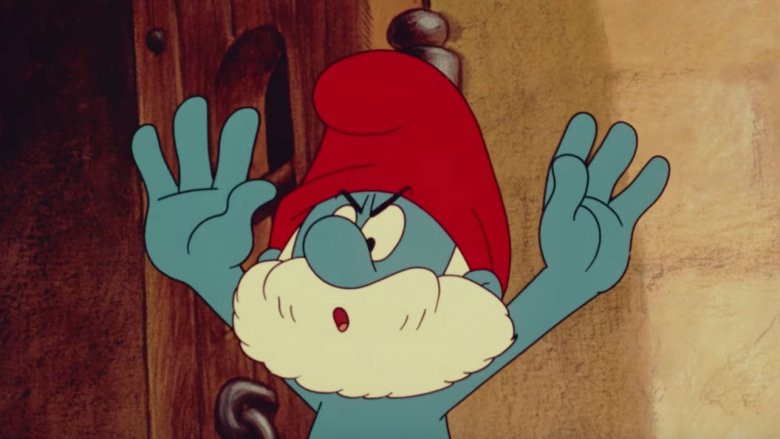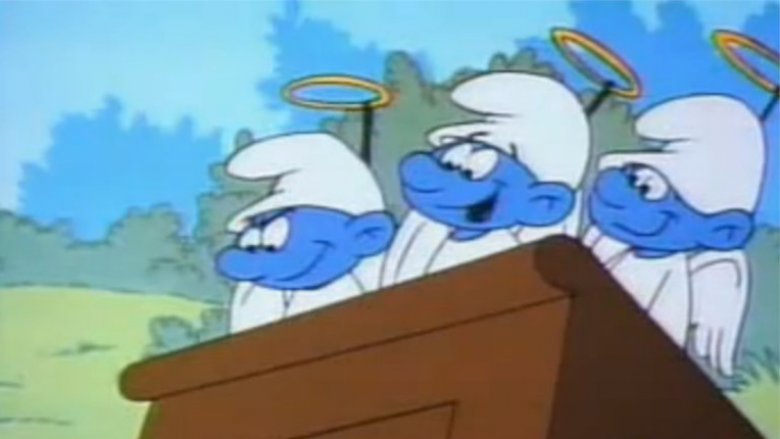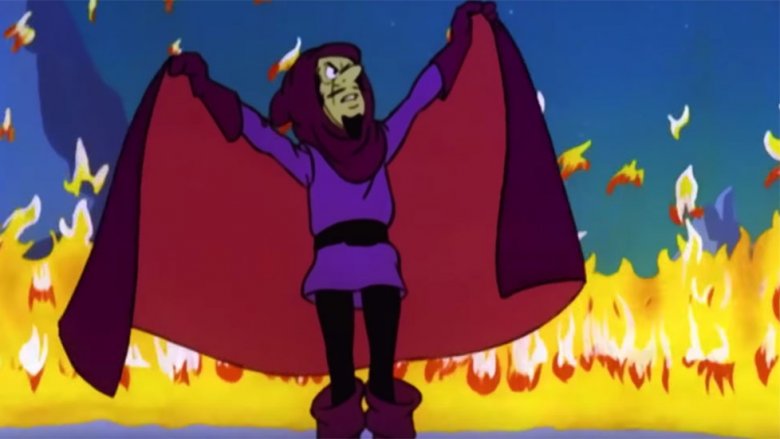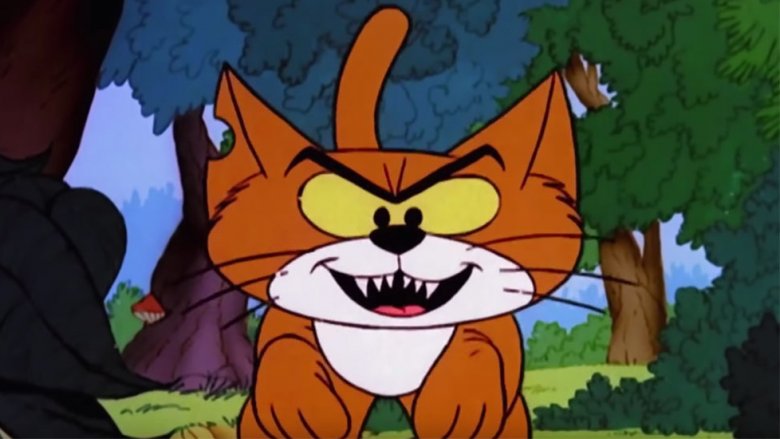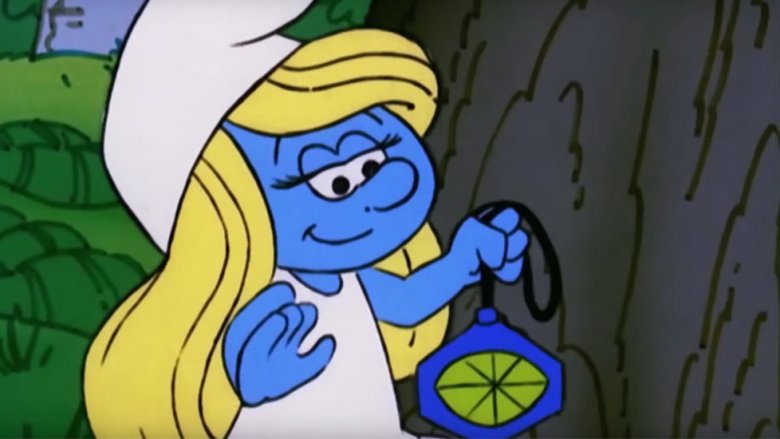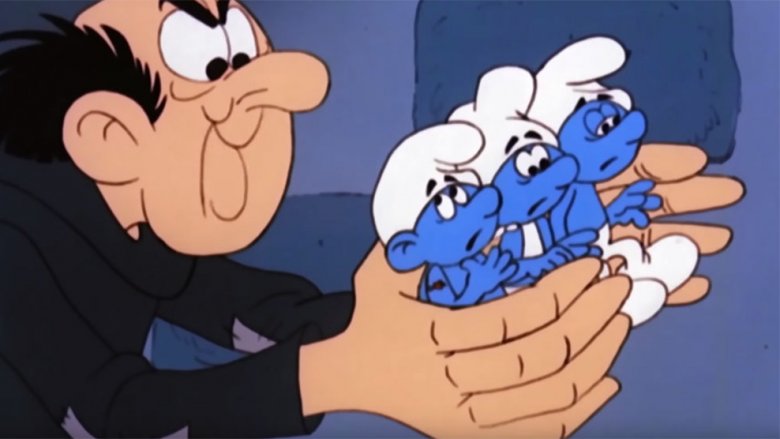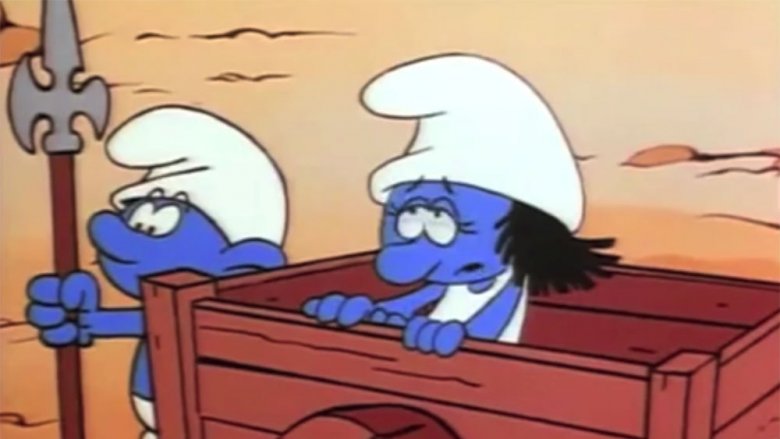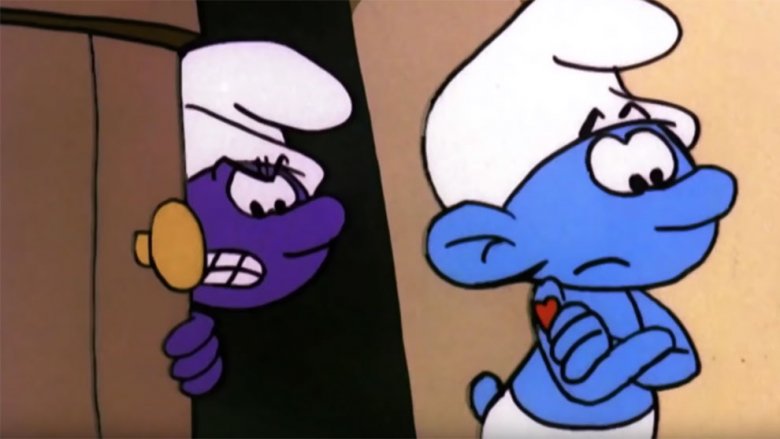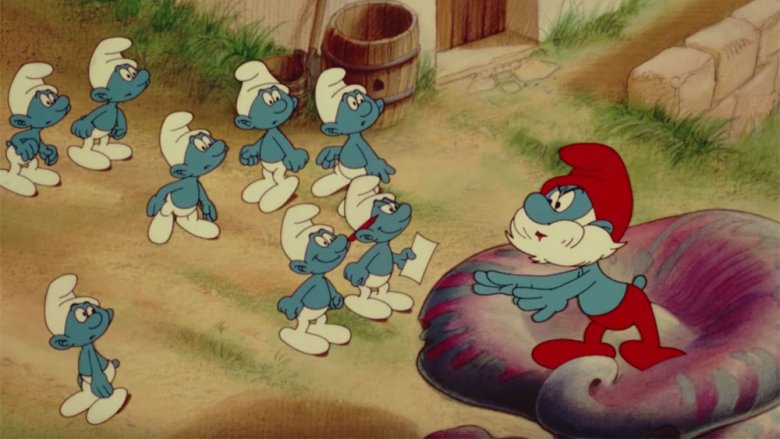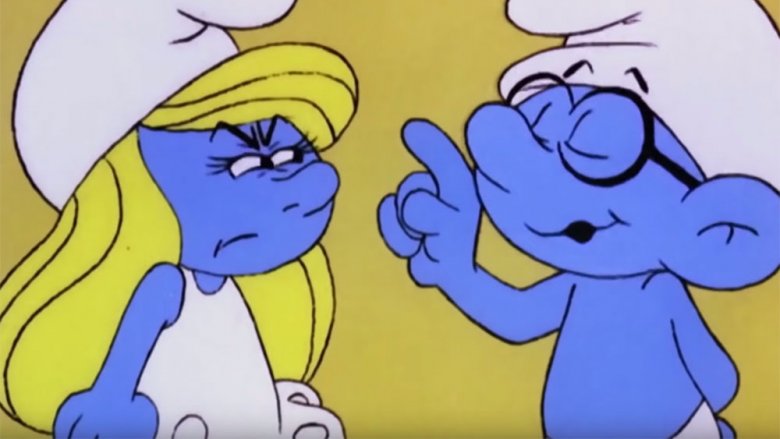Things Only Adults Notice In Smurfs
With all due respect to the French cartoonist Peyo and his seemingly endless army of little blue communists, the Smurfs don't really seem all that deep. The cartoon, which ran for a staggering nine seasons with 256 episodes between 1981 and 1989, was, after all, meant for tiny children. As a result, it tended to focus on pretty simple stories of good versus evil and easy morals for '80s babies to grow up with.
Here's the thing, though: no matter how simple and childish a cartoon might seem, there's always a whole bunch of adults behind the scenes making it. Whether they intend to or not, they inevitably wind up filling it with stuff that you're only going to pick up on once you're grown, and as surprising as it might be, The Smurfs is no exception. Here are the extremely smurfed up things that you only notice once you're an adult.
Gaslighting Gargamel
We might as well start off with the time that the most troubling elements of the Smurfiverse collided into one hugely smurfed-up mess: "Heavenly Smurfs," the second season episode in which the Smurfs terrorize Gargamel with the threat of eternal damnation in a lake of fire.
Okay, admittedly, they have a good reason for it, and it's not like they were entirely unprovoked. Gargamel, as you might recall from babytimes, was a pretty bad guy whose lack of morals was only matched by his lack of fashion sense. In "Heavenly Smurfs," Gargamel's out trying to do some murders when he winds up knocking himself out, and the Smurfs decide to take advantage of the situation by convincing Gargamel that he died and had been sent to the afterlife.
At first, as the name implies, they use a fog machine and a set of harps to create the illusion of heaven, but quickly reveal that Gargamel's life of sin and depravity has earned him an eternity being tortured by Satan, who is here represented by Hefty Smurf with a pitchfork. Much like Ebenezer Scrooge, he is offered the chance to reverse his fate if he changes his ways, and at first, this seems like a pretty good deal all around. People have changed their ways for worse reasons, after all, and if Gargamel actually becomes Goodgamel, the ends would justify a little blasphemous gaslighting, right?
Unfortunately, as ever, the nature of man and Smurf tends towards cruelty. As Gargamel attempts to be a better person, the Smurfs decide to take advantage of this by ordering him to perform manual labor around the village. In other words, they were gaslighting Gargamel into slavery with the threat of Hell. That doesn't seem very Smurfy, now does it?
The Devil went down to Smurftown
While the gaslighting is bad, it's also important to note that "Heavenly Smurfs" confirms that the Smurfs have a concept of both the afterlife in general, and the concept of a fiery Christian hell ruled over by Satan, the Author of All Lies, in particular. That shouldn't be all that surprising, though, if you consider that the Devil actually shows up himself to spread ruination a couple times throughout the series.
Of course, he's never actually called "the Devil," or "Lucifer," or "Satan, whom I beheld as he smurfed from Heaven as lightning," which is probably why you didn't notice when you were a kid. Instead, it's all subtext from when he shows up in The Smurfs Christmas Special as an unnamed character usually referred to by Smurfologists as "The Christmas Stranger."
He hunts down two children and makes a deal with Gargamel that involves granting him forbidden knowledge, which in this case is the location of the Smurfs' village, which Gargamel has a tough time finding despite the fact that it's a bunch of brightly colored mushrooms with doors and windows carved into them. At one point, the Stranger even summons a ring of fire and attempts to drag Gargamel and the kids to "their final journey." The only way this could be more clear is if he met them at the crossroads at midnight on a moonless night and taught them how to be, like, just super good at playing the blues.
Anyway, he winds up being defeated when the Smurfs sing a happy song at him. That's technically a happy ending, but it does mean that the Smurfs have the power to rebuke Satan, which raises the question of whether Papa Smurf is the messiah or just a messianic type. The Messmurfah, if you will.
A distressing namesake
While we're on the subject of Biblical figures making a surprise appearance in the world of the Smurfs, let's talk about Azrael for a moment. As a kid, you probably just thought this was a cool name for a cat, which it is. That's only part of the story, though.
As you got older and cracked open a few religious texts (or, alternately, Batman comics from the '90s), you may have learned that "Azrael" is traditionally the name given to the Angel of Death in Judaism and Islam. That might actually seem like a pretty appropriate name, given that Azrael (the cat) is frequently seen trying to kill and eat as many Smurfs as he can, but there are two things that make it stand out as an odd choice of name.
For one, Azrael (the angel) is not really depicted as being very catlike, unless your cat "is said to possess four faces, four thousand wings and seventy thousand feet, and eyes and tongues for every person in the world." If that is the case, then maybe hit up the local vet and get that checked out, as most cats don't have that many feet, and definitely don't have that many wings.
The other reason is that Azrael is usually viewed as a more helpful angel who shepherds the deceased from their Earthly lives to their eternal rewards, meaning that he's a less like the Grim Greaper and more along the lines of that dude in the Bone Thugs 'n' Harmony video. If Gargamel really wanted to stick to the theme, he would've named his cat Samael, the Poison of God, but it's pretty doubtful that NBC would've let them get away with that one.
Dial M for Smurfder
Hey, remember that time the Smurfs just straight up killed someone?
You probably don't, and that's okay, because it's not really presented as a stone-cold murder on the show, but it happened. The victim? Hogatha, a sorceress who goes even further than Gargamel in this show's attempt to teach children that physical beauty is absolutely equivalent to moral goodness, and that if you're not attractive, you don't even deserve to live.
Hogatha first appears in "Bewitched, Bothered, and Be-Smurfed," a season one episode that mostly involves her trying to recover a precious family heirloom — in this case, a locket that Smurfette finds out in the woods. After making zero attempts to find out who it actually belongs to, she starts tapping into its mystic powers to warp reality to her whims. Keep in mind that in this scenario, we are not supposed to think that Smurfette is the bad guy.
Anyway, at the climax of the episode, Papa Smurf chucks Hogatha's (basically stolen) locket into a fire, where it is destroyed. In addition to providing another dubious lesson to the kids — "Having a problem? Throw it into a fire!" — this also ends Hogatha's life. Or one of them, anyway. See, the magic of the locket has granted Hogatha multiple lives, and this just ends one of them. She does, however, claim to be destroyed and dissolves into smoke, so we're safe in considering this to be a full on killing. Just because someone has extra lives doesn't mean that it's okay to end one of them, after all. If you need proof, we suggest you consult the landmark court case of Mario v. Koopa (1983).
It's alive!
As a kid, you probably don't think too hard about Gargamel's motivations for committing Smurficide. He's the bad guy, and that's just what they do. Those motivations are, however, made pretty clear in the show itself... for certain values of "clear." He wants to eat them — specifically by frying, pickling, and serving them cold, which indicates that Smurfs, like garlic, are a pretty versatile ingredient — and then also use them to turn things into gold. How exactly this is going to happen is never really explained, but c'mon. If we can accept the existence of little blue socialists living in mushroom houses, then a little alchemy isn't that much of an ask.
There is, however, one pretty weird thing about this that becomes apparent if you think about the premise of the show as an adult. We know why Gargamel wants the Smurfs, but why does he need them? He's already a wizard and he owns a castle, which means that he is experiencing the kind of job security and home ownership that most Gen-Xers and millennials who grew up watching the show can only dream of. The bigger issue, though, is that if he really needs the Smurfs, can't he just, you know, make some?
He's more than capable of doing so, which we know because he made Smurfette. He creates her in his lab as a homunculus, and sends her to infiltrate the village, and since that works well enough that all of the actual Smurfs think she's one of them, he must've done a pretty good job at it. Do synthetic Smurfs just not taste as good? And if he can literally create life from things he has laying around in the pantry, does he really need help changing base metals to gold?
Smurfgenics
Ah, Smurfette. In all of children's television, there are few characters that have been considered to be more problematic, to the point where she has become synonymous with female characters who are defined by being "the girl" rather than having personalities and motivations of their own. If you really turn a critical eye towards her, though, there's a lot more that's going on besides the Smurfette Principle.
If you go back to the episode where she's introduced — the second of the three stories that aired when the show premiered on September 12, 1981 — you'll have to confront the fact that Smurfette did not originally have her familiar design. When she was created by Gargamel, who made her from "crocodile tears, half a pack of lies, and a hard stone for a heart," she had dark, frizzy hair and, to put it bluntly, a much larger nose. It's not until Papa Smurf does some magic that her hair turns blonde, her nose shrinks, and she becomes "a real Smurf." You can see where we're going with this, right?
Given that Gargamel himself has often been accused of being a Jewish stereotype, it's hard to not look at Smurfette's transformation as a troubling exercise in smurfy eugenics, especially since her origin story has distinct echoes of the Jewish legend of the Golem. Given that there are like three other stories in the show about someone either creating a fake Smurf or disguising themselves as a Smurf, none of which have this particular load of baggage, maybe Smurfette should just be, you know, a regular Smurf like the rest of them and not an icon of Smurfyan purity.
The Purple Smurfs
For all of Smurfette's problematic subtext, we have to admit that it's just that: subtext. It's doubtful that any of it was intentional, and to quote the great psychologist Smurfmund Freud, sometimes a smurf is just a smurf.
And then sometimes they do an episode where the Smurfs catch a disease that turns them into incoherent savages with darker skin who must be "cured" of their deviance before the entirety of smurfdom falls into degeneracy. No, seriously. It's "The Purple Smurfs," and you can give that one the most charitable read you want, and that's still going to be the actual sequence of events that happened on the show, no interpretation or subtext required. As the title implies, the afflicted Smurfs turn purple and within 11 minutes of the first sign of infection, Papa Smurf is lamenting the end of his society in a burning building.
That's pretty intense for kids, but even they wouldn't have a tough time realizing why this was a bad idea to put on TV in the '80s. It's only once those kids grow up, however, that they're likely to do the research necessary to discover that this story was actually based on one of Peyo's original comics, and underwent several major changes before it made it to American audiences on the show. What kind of changes? Well, the original story was called "The Black Smurfs." So, you know. There's that.
The Smurfunist Manifesto
The fact that American pop culture in the '80s was loaded down with Cold War propaganda isn't exactly a new revelation. It shows up everywhere, especially in obvious places like G.I. Joe, Red Dawn, and Rambo III. That, by the way, is the one where Rambo teams up with the Taliban to fight the Russians in Afghanistan. Hey, how'd that end up working out for everyone? Even Gymkata, the movie where Olympic gymnast Kurt Thomas has to invent a new martial art with the skill of gymnastics and the kill of karate, is about trying to secure missile sites before the Russians can get them.
The Smurfs, of course, is no exception. It just happens to be propaganda for the other side.
Again, it's not a new idea — it's actually pretty commonly accepted as a theme of the cartoon, although the intensity of the conspiracy theories about how Hefty's "Mom" tattoo actually stands for "Marxists Overthrowing Millionaires" varies from person to person. While you might not have recognized it when you were watching back then, the Smurfs apparently live in a society where each person's role, and even their name, is defined by what they have the best proficiency with, and they all collaborate with each other for the benefit of the whole group. In other words, from each (Smurf) according to their abilities to each (Smurf) according to their needs. The guy in charge even wears red, folks, and since Gargamel is trying to kill the Smurfs so he can use them for alchemy, they are literally in danger of being destroyed by capitalism. The Smurfs was many things, but subtle, it was not.
Ignorance is Smurf
There's one aspect of Smurf civilization (Smurfilization) that is far more troubling than the fact that they all live on a commune toiling for the good of the party, and it's one that the show is constantly using to get laughs from the children in the audience. As an adult, though, it becomes much more sinister. For all its illusions of being a utopian society where everyone is equal, there is a distinct and often violent hatred for education and intellectuals.
In practice, this mostly comes in the form of how literally every other Smurf in the village hates Brainy Smurf so much that they're constantly, violently catapulting him out of their homes because he's... well, brainy. He's the only Smurf who seems to take an interest in reading — a pursuit that most children's media is pretty keen on — but the others demonize him as pointless, and despite the fact that his very function in smurfciety is to be the smart one, they hate him for it.
Anti-intellectualism is often employed by totalitarian governments to control their populations, even to the point of manipulating access to histories. Taken to the extreme, you get George Orwell's classic novel 1984, but given that Papa Smurf has absolute control over the village to the point of even controlling the secret of their apparent immortality, The Smurfs isn't too far off. Braininess is Weakness. Ignorance is Strength. Papa is Watching You. We have always been at war with Gargamel.
